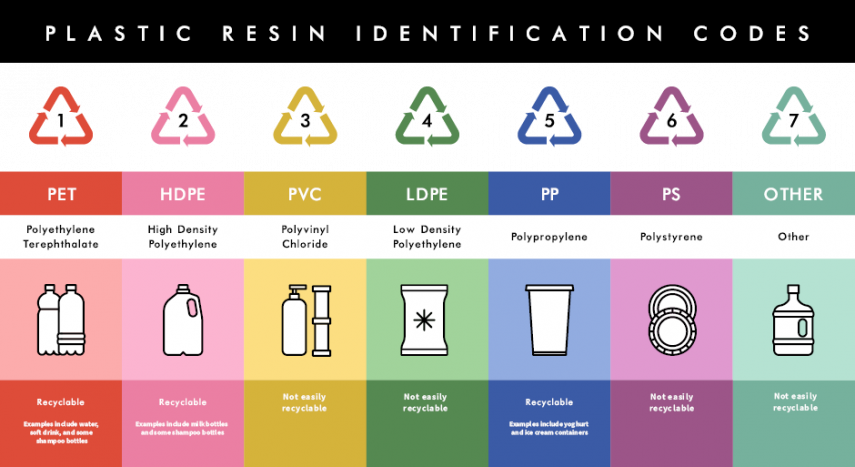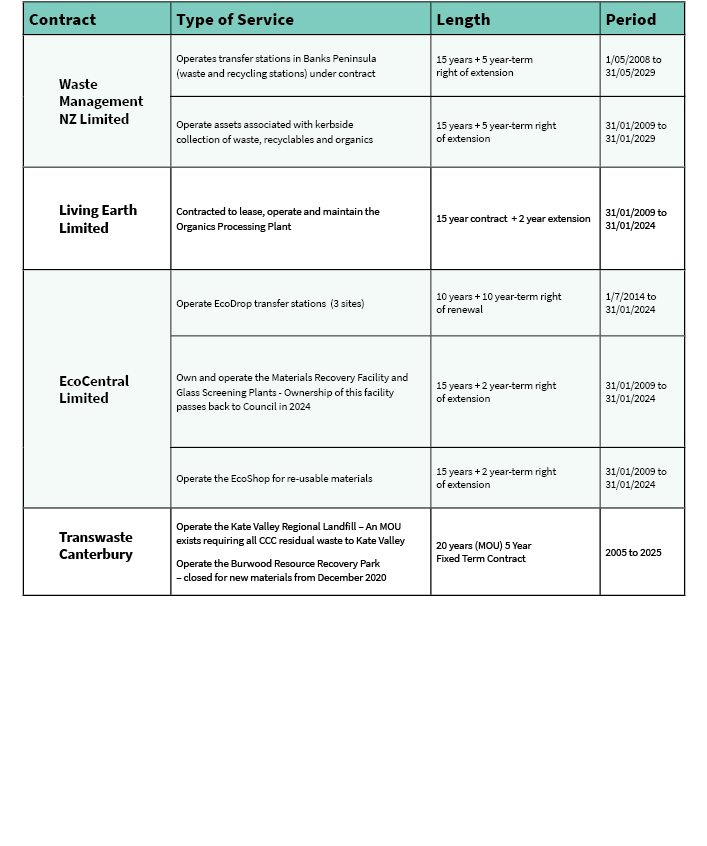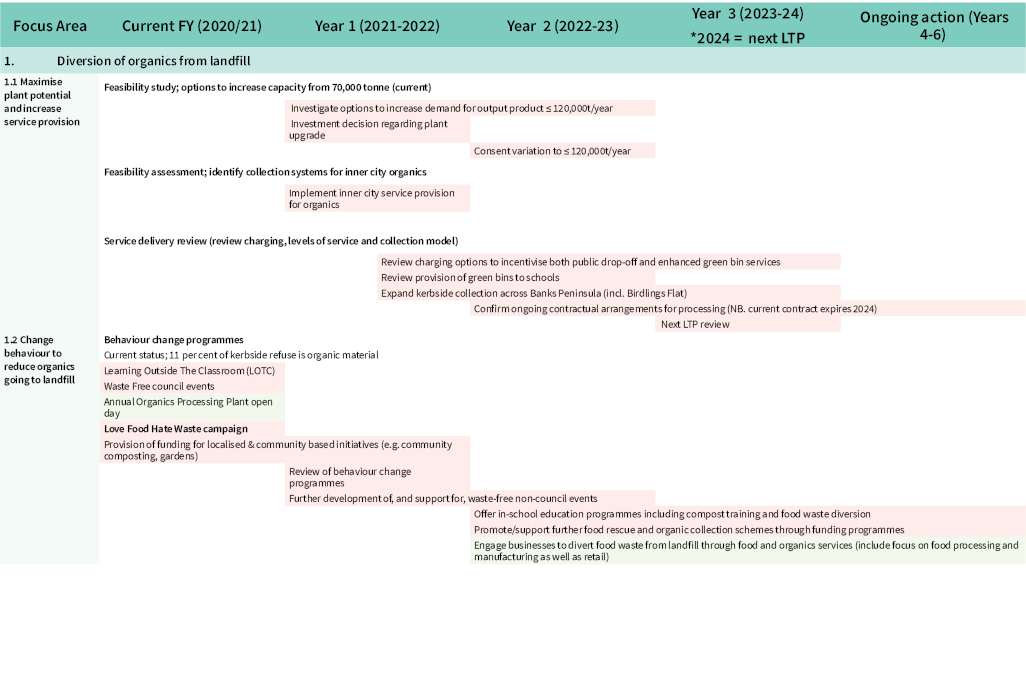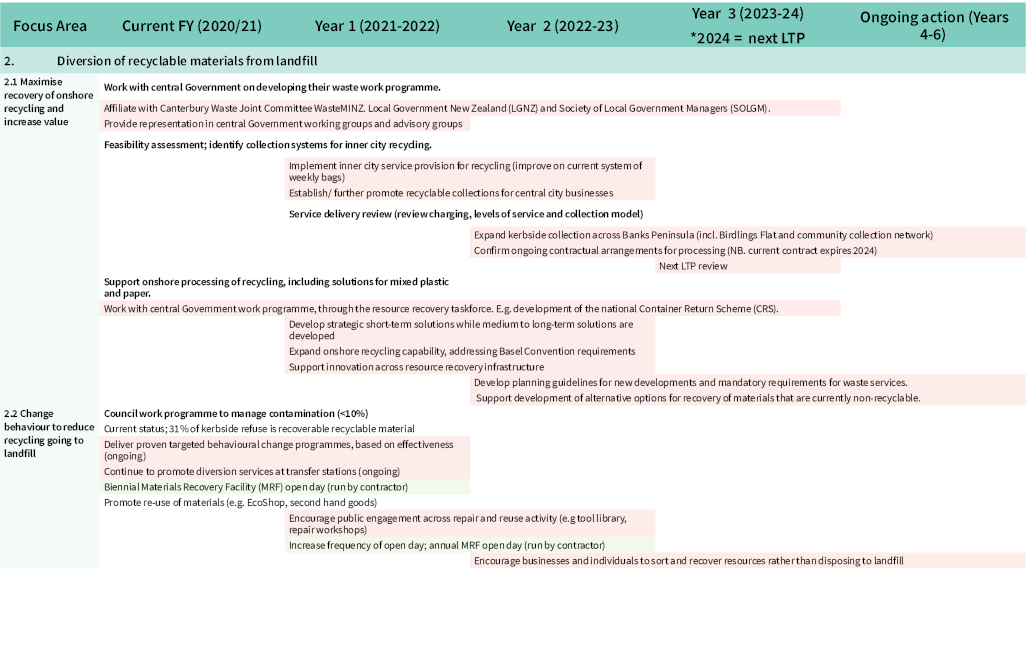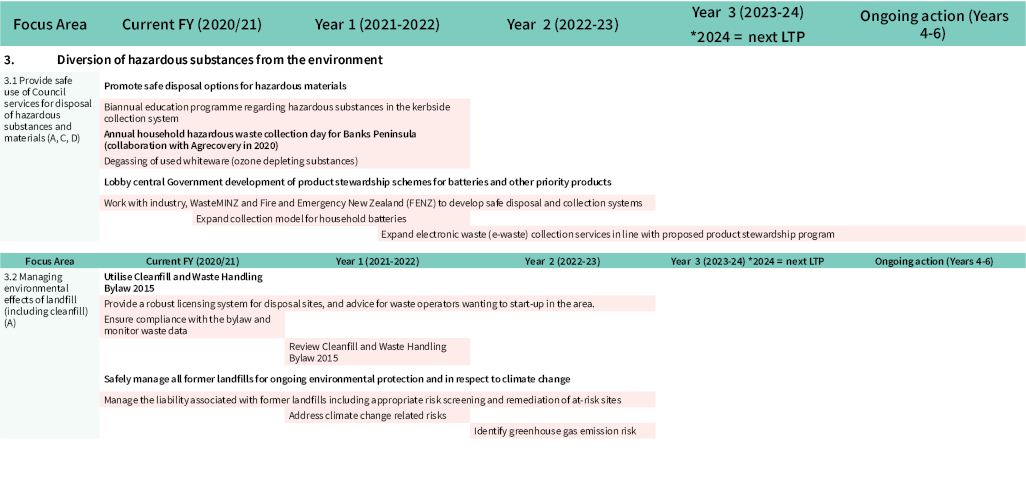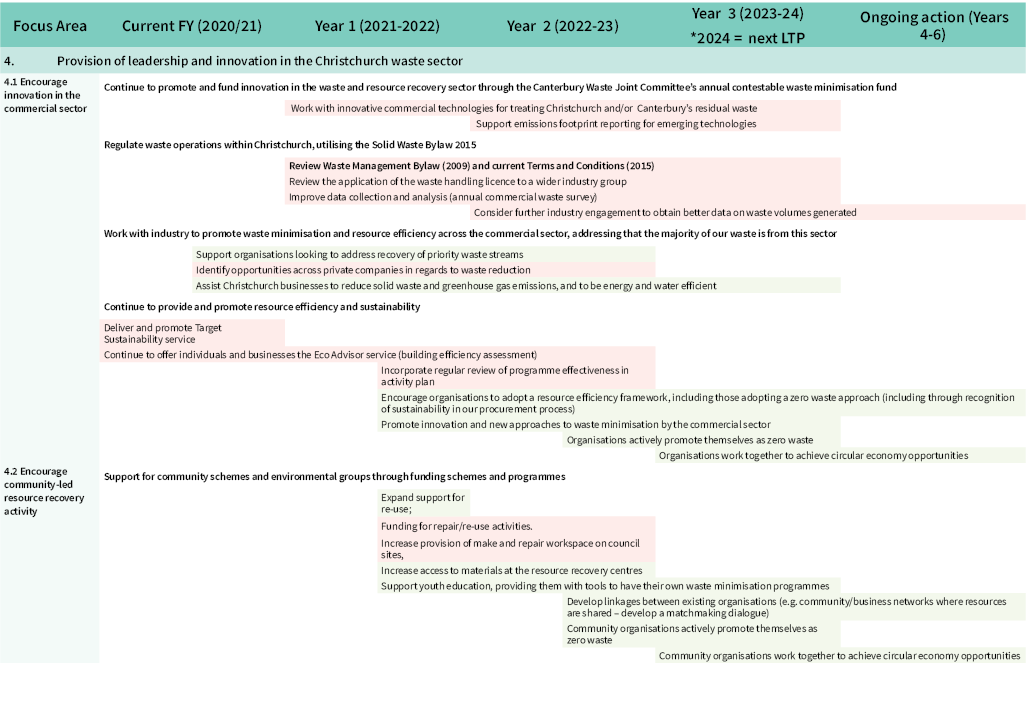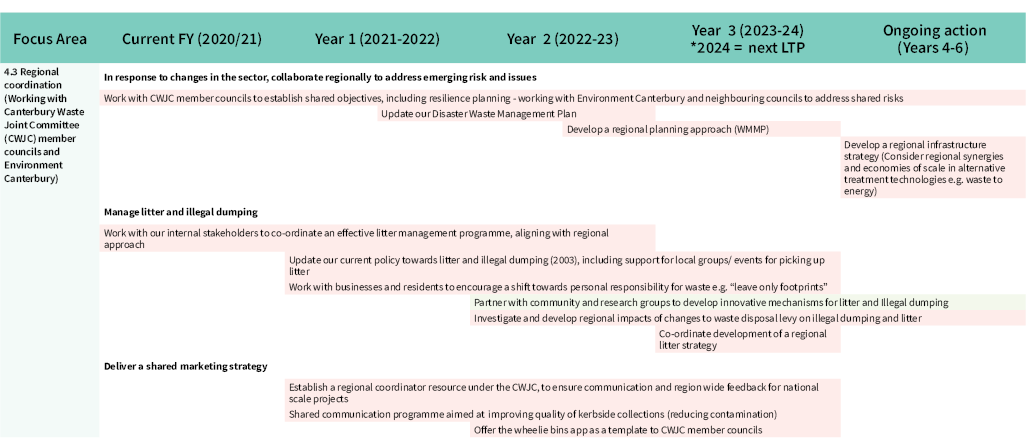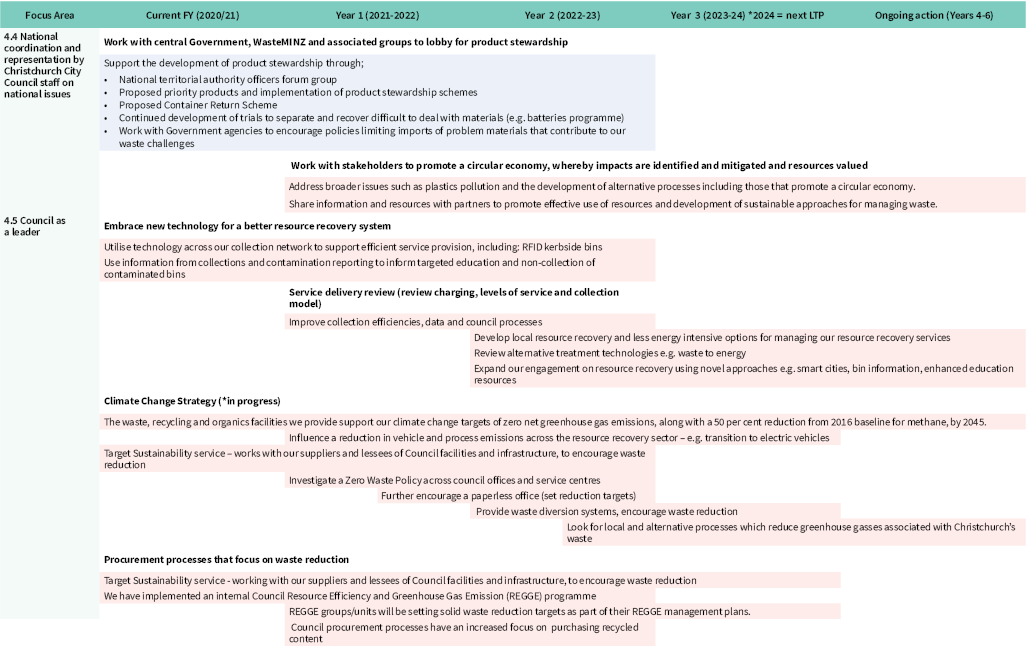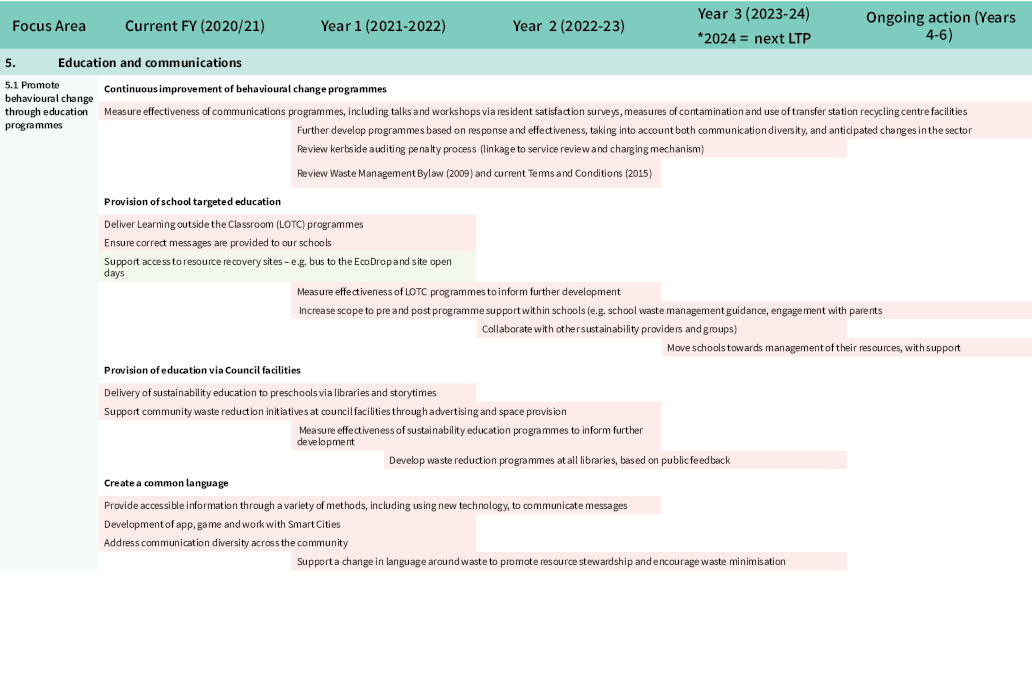The Draft Waste Management and Minimisation Plan 2020 has been prepared to meet the growing challenges in the waste sector. Our vision is that Ōtautahi-Christchurch is a sustainable city, working towards zero waste and a circular economy.
Share this
Consultation has now closed
The Hearing Panel - Councillor Jimmy Chen (Chairperson), Councillor Melanie Coker, and Councillor Jake McLellan - met on Monday 14 September 2020, to consider and deliberate on all submissions. They also heard from 12 submitters in-person.
The Hearing Panel report(external link), including their recommendations, was presented to the Three Waters Infrastructure and Environment Committee on Wednesday 21 October 2020. The committee agreed with all of the Hearing Panel’s recommendations as follows -
That the Three Waters Infrastructure and Environment Committee:
- Adopts the revised Waste Management and Minimisation Plan.
- Recommends to the Finance and Performance Committee that it incorporate the following items raised during the Hearings Panel deliberations in the service delivery review of solid waste services:
- Funding mechanisms designed to support and incentivise waste minimisation.
- Review of the current kerbside collection including opportunities for Increased flexibility for bin sizes and separated glass collection.
- Opportunities to increase the quantity and viable inputs for organics processing.
- Expansion of education to schools and organisations.
You can read the meeting minutes(external link).
The 2020 plan will provide the strategic direction for waste management in Christchurch for the next six years.
The Waste Minimisation Act requires us to prepare and to periodically review a waste management and minimisation plan. In 2019, we looked at our existing 2013 Waste Management and Minimisation Plan, other policies, and completed a waste assessment to provide the foundations for this plan. At the same time, we started working with people involved in waste management and minimisation across the region and nationally. This helped us understand the current challenges in Christchurch, shape the vision and provided a basis for the action plan.
The 2020 plan will take into account changing conditions in international recycling markets and the need for Christchurch to move progressively towards waste reduction, reuse of resources and circular economy. The focus of the Draft Plan is not only on the services we provide, but considers broader waste management and minimisation objectives – both at a city and regional level.
Our vision is that
Ōtautahi-Christchurch is a sustainable city, working towards zero waste and a circular economy.
The Draft Plan recognises that achieving our vision will require more than improved Council services. Individuals, businesses, regional partners and central Government will all need to contribute to the plan’s success.
Please consider the Draft Plan (in the sections below or you can download in full [PDF, 3.1 MB]), 2019 Waste Assessment [PDF, 562 KB] and proposed action plan before completing a submission.
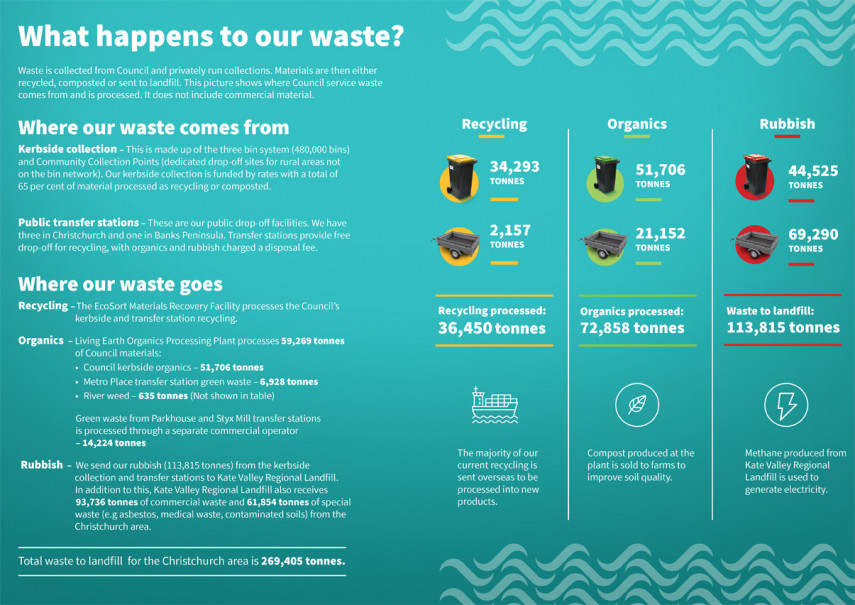
You can download the Summary of Information [PDF, 3.5 MB] if you prefer to read a shorter document.
Managing and minimising waste is a key council responsibility. We need to deliver an effective and efficient waste system, that maximises opportunities to re-use materials and benefits current and future generations.
The Draft Waste Management and Minimisation Plan 2020 has been prepared to meet the growing challenges in the waste sector. The focus of this plan is not just about the services we provide, but considers broader waste management and minimisation objectives – both at a city and regional level.
A significant shift in the way we view waste is required. This involves reducing our reliance on landfill, increasing opportunities to re-use materials (resource recovery) and working towards our vision of zero waste.
Our vision for an effective waste system is:
Ōtautahi-Christchurch is a sustainable city, working towards zero waste and a circular economy
The 2013 plan was developed three years into our new three-bin kerbside system and during the recovery period of the Canterbury earthquake sequence. This plan builds on our achievements since 2013 and provides a foundation and action plan for achieving our vision.
Current residential waste generation
The Christchurch kerbside collection is comprised of three waste streams:
- recycling (approximately 35,000 tonnes/year)
- organics (approximately 53,000 tonnes/year)
- rubbish (approximately 45,000 tonnes/year)
We also have four transfer stations, providing public drop-off facilities, and a network of rural collection points. Central city properties have a bagged service for recycling and rubbish.
We have a range of mechanisms to promote waste management and minimisation. These include:
- Waste recycling and organics kerbside collection service
- Education programmes
- Bylaws
- Collaborating with regional councils and industry representatives
To achieve the objectives identified in this plan, we’ll need to build on existing regional collaboration. This includes:
- Shared use of the Organics Processing Plant and Materials Recovery Facility
- Joint communications and public information
- Working together to deliver innovation in the waste sector
- Working towards establishing a regional infrastructure strategy for waste, recycling and organics
- Potentially developing regional waste management and minimisation plans in the future.
Through this plan, we’ll review the efficiency and future viability of our current system. This includes looking at the collection, processing and disposal options for materials we collect. To achieve our vision, we will also look at the broader context of waste generated across the Christchurch area, including commercial and industrial sources and the ability to influence waste reduction in these sectors.
Minimising waste and using resources sustainably is a key community outcome in our strategic framework.
Everyone can help reduce waste and lessen their impact on the environment.
Waste minimisation, and the efficient use of our natural resources, is fundamental to our current and future social, economic, cultural and environmental wellbeing. Developing solutions to our current waste challenges is the responsibility of all Christchurch residents, businesses, organisations and government. As a council, our role is to lead and facilitate solutions to eliminate waste and support overall wellbeing.
In Christchurch over 200,000 tonnes of waste is sent to landfill each year, the equivalent of 538kg per person (*excluding special waste). Another 115,000 tonnes is processed through our recycling and organics facilities (diverted from landfill). To reduce waste, we need to rethink how we use materials, and embrace a more circular economy that moves towards zero waste. This plan provides the strategic direction and activities that we will invest in over the next six years.
How we manage waste, recycling and organics services needs regular review. When the 2013 Waste Management and Minimisation Plan was developed, our three-bin system was well-established, innovative and receiving consistently high resident satisfaction. Since then, there has been a global change in waste management and increased public interest in waste reduction. To update our plan we need to assess what we are doing, and what we need to start, to achieve a zero waste future. An immediate challenge is to reduce contamination in our recycling bin service.
Looking forward, we need to work more closely with businesses and industry to support waste diversion. To achieve our goals around a low-waste economy, we need to stimulate innovation and increase the opportunity to recover valuable materials from the waste cycle.
The national direction for this statutory plan is set by the New Zealand Waste Minimisation Act 2008 (the Act) and the New Zealand Waste Strategy 2010. Under the Act, councils have a responsibility to ‘promote effective and efficient waste management and minimisation’.
A summary of how are services are delivered in provided below that outlines each of our key contracts.
Contracts
A summary of our key resource recovery contracts is provided below:
There are a number of statutory requirements and international agreements that frame our approach.
Waste Minimisation Act 2008
The purpose of the Waste Minimisation Act(external link) is to encourage waste minimisation and a decrease in waste disposal in order to protect the environment from harm; and provide environmental, social, economic and cultural benefits.
The Act outlines the responsibilities of territorial authorities in relation to waste management and minimisation as:
- Promoting effective and efficient waste management and minimisation within their districts and
- Spending the funding provided by the national waste disposal levy on matters to promote or achieve waste minimisation in accordance with the waste management and minimisation plan.
The New Zealand Waste Strategy 2010
The New Zealand Waste Strategy 2010(external link) provides direction to local government, businesses (including the waste industry), and communities on ways to:
- Reduce the harmful effects of waste to the environment and human health
- Improve the efficiency of resource use
- Capitalise on potential economic benefits.
Other statutes
Other statutes that are relevant to waste minimisation and management in a broader context include:
- Local Government Act 2002
- The Resource Management Act 1991
- The Hazardous Substances and New Organisms Act 1996
- The Climate Change Response Act 2002 (as far as it relates to disposal facilities such as Kate Valley Landfill)
- The Health Act 1956
- Litter Act 1979
- Health and Safety at Work Act 2015
- Ozone Layer Protection Act 1996
- Imports and Exports (Restrictions) Act 1988
- Customs and Excise Act 1986
- Biosecurity Act 1993.
There are several international agreements that New Zealand is party to that may affect the import and export of waste including recyclable materials, including:
- Montreal Protocol on Substances that Deplete the Ozone Layer (Montreal Protocol)
- Basel Convention on the Control of Transboundary Movements of Hazardous Wastes and their Disposal
- The Convention to Ban the Importation into Forum Island Countries of Hazardous and Radioactive Wastes and to Control the Transboundary Movement and Management of Hazardous Wastes within the South Pacific Region (Waigani Convention(external link))
- Organisation for Economic Co-ordination and Development Decision C(2001)107/FINAL (OECD Hazardous Waste Decision)
- Stockholm Convention on Persistent Organic Pollutants.
Council bylaws
The following Council bylaws relate to waste minimisation and management:
Waste Management Bylaw 2009: The purpose of this bylaw is to prevent the contamination of recyclable materials (including those collected through the kerbside collection service) and maximise their use. It is also to ensure the safe and efficient collection of waste and to prevent waste becoming a problem.
Cleanfill and Waste Handling Operations Bylaw 2015: The purpose of this bylaw is to:
- Regulate and monitor operators collecting, managing, storing and using cleanfill and waste within the city through a licensing process
- Protect, promote and maintain public health and safety
- Provide comprehensive data and information for planning and waste management and minimisation purposes.
Other statutory documents
Mahaanui Iwi Management Plan 2013
Ngāi Tahu runanga have created the Mahaanui Iwi Management Plan to guide councils’ decisions about the environment and protection of resources. The Plan outlines the specific cultural (tikanga) issues associated with the disposal and management of waste. These include the need for waste management practices to protect cultural values such as mahinga kai and wahi tapu and the requirement for waste minimisation to be a basic principle of, and approach to, waste management.
Canterbury Regional Policy Statement 2013
The Canterbury Regional Policy Statement provides an overview of the resource management issues in the Canterbury region, and the objectives, policies and methods to achieve integrated management of natural and physical resources. Specific chapters (18-19) address Hazardous Substances and Waste Minimisation and Management.
This plan responds to significant changes in waste and resource recovery at a global level and the international, national, and more local responses to it.
International context
Earth has finite resources, yet our current approach often sees products used for short periods of time and disposed to landfill. Minimising waste leads to a more efficient use of resources, less pollution and less harm to our environment. It helps enable us to preserve our environment for future generations. Currently, we waste many valuable resources that could be recovered and reused. Our approach is causing landfills to fill up and our environment to become polluted by discarded products. These impacts are often not visible when we purchase products.
https://www.mfe.govt.nz/waste/why-reducing-reusing-and-recycling-matter(external link)
The true cost of waste is more than just the cost of disposal. It also includes the additional cost of raw materials, energy and labour involved in making, transporting, selling and using the products. This can be five to 20 times higher than the cost of disposal.
https://www.plastics.org.nz/environment/efficient-manufacturing/waste-minimisation(external link)
Climate change impacts
The process to extract fossil fuels required for a plastic product, including the related land disturbance, transport, manufacturing and distribution process, emit significant amounts of carbon dioxide into the atmosphere. Disposal also emits greenhouse gas emissions, the severity of which depends on the method of disposal. Research indicates that 36 per cent of plastic produced is for the purpose of single-use packaging. A benefit of reducing reliance on single-use plastics is the significant reduction of greenhouse gas emissions. While recycling diverts waste from landfill, studies indicate that 92 per cent of plastics are not recycled after their initial intended use.
https://www.pmcsa.ac.nz/topics/rethinking-plastics/(external link)
https://www.ellenmacarthurfoundation.org/assets/downloads/publications/NPEC-Hybrid_English_22-11-17_Digital.pdf(external link)
International recycling markets
There has been a significant shift in the international recycling markets. China’s National Sword Policy[1], introduced contamination thresholds for their importation of recycling products at 0.5 per cent. The thresholds came into force in March 2018[2] and severely disrupted exports for paper and plastic materials. This has created a surplus of products with contamination greater than 0.5 per cent as there is less demand for them. A flow-on impact to other South East Asian markets, has significantly reduced the prices for paper, cardboard and mixed plastics.
In 2019 the Norwegian Amendment[3] to the Basel Convention on the Control of Transboundary Movements of Hazardous Wastes and their Disposal[4] was adopted. The amendment, effective from January 2021, means exporters of contaminated, or hard-to-recycle plastic waste, will require consent from the governments of receiving countries before shipping. While the amendment will not prevent the trade of plastic, it incentivises trade in high quality, sorted, clean plastic and helps ensure that materials are being shipped for the purposes of recycling.
[1] https://www.wasteminz.org.nz/wp-content/uploads/2018/11/WasteMINZ-2018-Mike-Ritchie-on-China-National-Sword.pdf(external link)
[2] https://recyclinginternational.com/business/industry-concern-as-china-confirms-new-thresholds-for-contaminants/2068/(external link)
[3] https://www.ban.org/news/2019/5/10/basel-convention-agrees-to-control-plastic-waste-trade; https://www.lawsociety.org.nz/news-and-communications/latest-news/news/nz-agrees-to-basel-convention-plastic-waste-amendment(external link)
[4] http://www.basel.int/(external link)
National response
In response to issues in the waste, recycling and organics industry, the Government has developed a broad work programme which includes:
- A review of the Waste Disposal Levy (and indicative pricing for waste diversion)
- Product stewardship, where everyone involved (producers, brand owners, importers, retailers, consumers, collectors, and re-processers) in the lifespan of a product is called upon to take responsibility to reduce its environmental, health, and safety impacts
Additional legislative controls to support a more circular economy.
https://sustaintrust.org.nz/blog/making-it-mandatory-expanding-product-stewardship-in-nz(external link)
What is a Circular Economy?
As outlined by the Ministry for the Environment[1], a circular economy is about ensuring we can unmake everything we
make. It is based on three principles, outlined below[2].

A circular economy
[1] https://www.mfe.govt.nz/waste/circular-economy(external link)
[2] https://www.ellenmacarthurfoundation.org/circular-economy/concept(external link)
New Zealand remains constrained by our relative scale of production and large distances between major population bases, meaning the solutions to our waste challenges are often more difficult than for more populated countries. Therefore, the types and location of new infrastructure needs to be considered on a national scale. Information on the Ministry for the Environment’s work programme is provided in Appendix A.
Working with industry to cut plastic waste
The New Zealand Government became a signatory to the New Plastics Economy Global Commitment in October 2018. This initiative, led by the Ellen MacArthur Foundation and United Nations Environment Programme, seeks to address the root causes of plastic waste and pollution. This is a global commitment bringing together governments, businesses and NGOs in adopting a circular economy approach to plastics with key targets in place for 2025.
As a first step, the Ministry for the Environment has worked with 15 local and multi-national companies to sign the New Zealand Plastic Packaging Declaration. This is a joint commitment to use 100 per cent reusable, recyclable or compostable packaging in their New Zealand operations by 2025 or earlier.
Changes to commodity prices for recyclable materials
We’re part of a national taskforce the Government has set up, working with local councils and the waste industry, to identify solutions where prices have reduced for the recyclable materials we collect. Policies introduced by China, to ban or restrict the import of a number of different products, including low-quality plastics, has resulted in low sales prices for recyclables. This market change has highlighted that we cannot rely on the international market to take our low-value recyclable material. We need to raise the quality of what is collected, and how it is processed, so we can provide higher-quality recyclables for sale. In the medium to long term, more onshore processing solutions are needed.
Regional approach
Canterbury councils have historically worked together to address waste challenges. This includes the establishment of Kate Valley Regional Landfill, through Transwaste Canterbury, a public private partnership half owned by five councils, including Christchurch City Council. Christchurch resource recovery facilities also service our neighbouring councils, providing regional economies of scale for major infrastructure.
We collaborate with other territorial authorities in the Canterbury region to plan, and implement, waste minimisation programmes through the Canterbury Waste Joint Committee and its Canterbury Regional Waste Management Agreement. The joint committee, with the assistance of Environment Canterbury, also coordinates regional management of hazardous waste.
Local situation
Christchurch has had a successful three-bin kerbside system since 2009, which has diverted approximately 65 per cent of household recyclable and organic materials from landfill. As shown in Figure 4 below, through the kerbside collection service, Christchurch residents contribute approximately 20 per cent of the general waste sent to the Kate Valley Landfill each year. Commercial waste from transfer stations, both Council-owned and private, make up the majority of all waste to landfill.

The recent changes in international markets, including the decline in recycled product prices and higher quality standards, threaten the ongoing viability of recycling. Our current recycling process sorts and exports mixed paper and plastic with an average contamination level of 5 per cent. Materials recovery facilities processing mixed recyclables were never designed to achieve the 0.5 per cent[1] now required in some markets. There are limited options for onshore facilities to recycle some plastic resin codes. There are no paper mills in the South Island and the facilities in the North Island have no capacity for additional supplies of mixed paper.
To remain viable, EcoCentral, which processes Christchurch’s recycling, has introduced a $90 per tonne processing fee at the Material Recovery Facility. Current estimates show the required processing fee could increase to $180 per tonne. Despite the significant cost,
there is value in maintaining our current system through this period of market uncertainty, as it preserves our ability to meet the upcoming challenges in the recycling sector and reduces waste to landfill.
We have a composting operation for kerbside organics, whereby the household food and garden waste is turned into certified organic compost. This compost is supplied to the agricultural and viticulture industries. The value of adding compost to soils can be measured in increased crop yield and carbon sequestration, the amount of carbon a plant can store.
[1] https://www.mfe.govt.nz/sites/default/files/media/Waste/proposals-for-short-to-medium-term-responses-to-national-sword.pdf(external link)
Climate change and waste minimisation
Maximising the use of existing products and materials is a vital part of reducing our emissions. The following greenhouse gas emissions targets have been set for Christchurch:
- Net zero greenhouse gas emissions by 2045, and a 50 per cent reduction from the 2016/2017 baseline levels by 2030 (excluding methane)
- At least a 25 per cent reduction in methane by 2030 and 50 per cent reduction by 2045 (from baseline year 2016/2017)
In 2017, nine per cent of our carbon footprint for the Christchurch community was caused by waste disposal.[1] This is the end-of-life carbon footprint of our resources and does not include the full lifecycle emissions impact of the products and materials that have become waste.
As a Council, we’ve set our own target of being net carbon neutral for our operations by 2030. A climate change strategy for the Christchurch district is under development that shows the importance of minimising waste as part of a transition to a low carbon and more circular economy.
Through this plan, we are looking to reduce the impacts of our current resource recovery system. The waste hierarchy provides a simple framework in regards to resource use.
It shows that waste reduction activities make the largest difference to support waste minimisation. This is followed by diversion, with disposal as a last resort. The benefits of addressing waste at the point of generation (both environmental and economic) will influence our actions.
This is because reducing waste and recovering valuable resources, resolves many of the issues associated with disposal. A shift towards circular economy principles and waste reduction will be supported by enhanced resource recovery systems and a focus on local solutions.
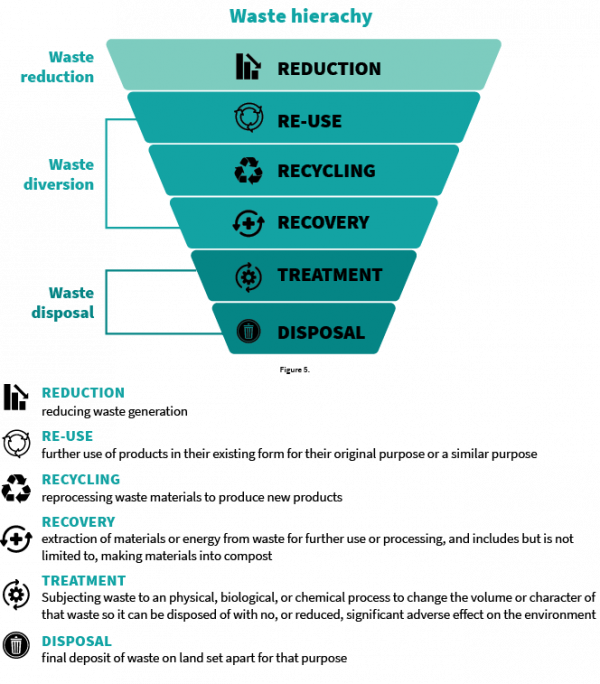
Developing innovative approaches to managing waste is critical to maximising the use of existing resources and developing viable alternatives to landfill.
As a local council, we‘re responsible for managing waste that our communities produce. In addition, we’re able to act as a facilitator, helping the community to:
- Create an environment to more effectively manage resources
- Reduce the waste produced by individual households and businesses.
We work closely with other public sector partners and community organisations to develop and support initiatives that reduce reliance on landfill.
Some of our partnerships include:
- central government
- other local authorities and the Canterbury Joint Waste Committee
- the Canterbury District Health Board
- industry representatives, including WasteMINZ, Local Government New Zealand, our contractors, other waste providers and new and emerging technologies
- research organisations and consultants, including universities, research institutes and sector interest groups community groups and environmental NGOs.
Our partnership with Papatipu Rūnanga is guided by Te Tiriti o Waitangi-the Treaty of Waitangi. Through the implementation of this plan, we’ll will work closely with Papatipu Rūnanga as Treaty Partners and support their kaitiaki (guardian) role.
There are six Papatipu Rūnanga who hold mana whenua in their traditional takiwā or territories that lie within our area of jurisdiction:
- Ngāi Tūāhuriri Rūnanga (takiwā also extends beyond our jurisdiction)
- Te Hapū o Ngāti Wheke (Rāpaki)
- Te Rūnanga o Koukourārata
- Ōnuku Rūnanga
- Wairewa Rūnanga
- Te Taumutu Rūnanga (takiwā also extends beyond our jurisdiction).
Mana whenua represents the ability to influence and exercise control over a respective area or region and act as its kaitiaki. Mana whenua is derived from whakapapa, and protected and secured through:
- continued occupation of ancestral lands (ahi kā roa)
- continued use of resources (e.g. mahinga kai)
- protection of the mauri (life force) of resources and the environment for generations to come, as stated in the Ngāi Tahu whakatauki, ‘mō tātou, ā, mō kā uri ā muri ake nei’ (for us and our children after us).
To create an awareness and understanding of what is important to tangata whenua and why, the six Papatipu Rūnanga have developed the Mahaanui Iwi Management Plan, a mana whenua planning document that is an expression of kaitiakitanga and rangatiratanga (self-determination).
Within the Mahaanui Iwi Management Plan, waste management is primarily identified in the Issue of Significance (Issue P7) relating to Papatūānuku, the land, with cascading effects to other Issues of Significance throughout, reflecting the holistic management approach of Ki Uta Ki Tai (from mountains to the sea).
This section provides guidance and awareness on specific issues associated with the disposal and management of waste. The associated policies highlight the opportunities for Papatipu Rūnanga and us to work in partnership to ensure that waste management and minimisation practices protect significant values such as mahinga kai and wāhi tapu and are consistent with Ngāi Tahu tikanga.
By working together, we can better understand the challenges and collectively move beyond our existing practices.
Ōtautahi-Christchurch is a sustainable city, working towards zero waste and a circular economy
Our guiding principles:
Pare Kore – Zero Waste
Zero waste is about how we responsibly make and use products, minimising social or environmental harm. This includes avoiding damages resulting from greenhouse emissions or discharges to land or water.
Ōhanga Āmiomio – Circular Economy
A circular economy is the idea that all products can be made so that at the end of their initial use they have a value (e.g. can be re-used, recycled or repurposed). This reduces waste, pollution and greenhouse gases.
Rangatiratanga – Leadership
We will all demonstrate leadership and best practice in minimising and managing waste. For our council this includes continually improving our own operations, and working with our partners and communities to develop and implement solutions.
Kaitiakitanga – Guardianship
As partners, we will work with Papatipu Rūnanga, to share responsibility to ensure the life-supporting functions of the environment are maintained and protected for those who come after us. Sustainable waste management and minimisation protects our environment.
Ngātahitanga – Collaboration
We will work with groups and organisations on initiatives to minimise waste, recover resources and progress our vision for zero waste.
Te Tatanga Mātāpono – The proximity principle
This is about using local and national resource recovery solutions, where possible. Reducing reliance on international markets provides environmental and economic benefits.
To help achieve our vision, we’ve developed the following goals and objectives:
Goals
- Everyone has access to recycling, resource recovery and waste management services.
- Businesses and individuals understand that reducing and minimising waste is their responsibility, as well as ours.
- Valuable resources are re-used or recycled and don’t go to landfill.
Objectives
- Make sure our waste management facilities and services maximise resource recovery and avoid adverse effects to people and the environment.
- Make sure our kerbside recycling and organics collection has minimal contamination levels, allowing for sorting of products, which are then suitable for processing or sale. This creates long-term economic benefits.
- Collaborate with industry operators and central Government, to support a regional and national transition to zero waste and a circular economy.
- Reduce our reliance on overseas markets for recyclable materials
- Make sure our waste, recycling and organics facilities support our climate change targets. These are zero net greenhouse gas emissions, and to halve the 2016 baseline for methane, by 2045.
This plan fits within a broader framework of Council strategies and policies relevant to waste minimisation and management.
Existing Council policies
Resource Efficiency and Greenhouse Gas Emission policy
Our Resource Efficiency and Greenhouse Gas Emissions policy includes a commitment to continually and systematically improve our performance in solid waste generation through the implementation, monitoring and review of policies, processes and services.
Sustainability Policy
This provides an operational definition of the term sustainability so that we can more consistently apply it to our activities. It identifies the need to be more efficient with resources, circular in our approach to material and fully powered by renewable energy sources and eliminating harm to people and the environment. This in turn enables us to meet social needs now, and into the future.
http://ccc.govt.nz/the-council/plans-strategies-policies-and-bylaws/policies/sustainability-policies/sustainability-policy/(external link)
Sustainable Procurement Policy
In 2019, we launched our Sustainable Procurement Policy – a different way of looking at how we select products, contract work and services. The policy focuses on sustainability in procurement, aimed at enhancing the environment, including minimising waste, and improving social and economic aspects of life in Christchurch.
Free Waste Dumping Policy
This is around managing requests for free or reduced-fee waste disposal. Free waste disposal is provided for community clean-ups when there is a public benefit.
Operational targets
The Long Term Plan 2021-31 will include level of service targets for resource recovery services as outlined in Figure 6. These are focused on continuous improvement and do not rely on large-scale change either at Government level, or through changes to our services or facilities. Additional targets have been set within the action plan that focus on addressing the broader, strategic challenges in the journey towards zero waste and a circular economy.
Organics
Total organic material collected through Council services and facilities and diverted for composting is at least 190kg per person each year.
Recyclables
Total recyclable materials collected through Council services and facilities and received for processing at the Materials Recovery Facility is at least 103kg per person each year.
Waste
Total residual waste collected by Council kerbside services is less than 119kg per person each year.
Our last Waste Management and Minimisation Plan, completed in 2013, including a set of targets and an action plan. This section provides a summary of achievements against these targets and actions.
Kerbside collections
The council has a three-bin collection service for rubbish, recycling and organics. This service is well established, diverting over 65 per cent of residential kerbside waste from landfill. The 2020 General Services Satisfaction Survey identified kerbside collection as one of our top performing services, where satisfaction levels are 85 per cent or higher.
Diversion from landfill through the kerbside recycling and organics collections is over 228kg per person, compared to 115kg per person sent to landfill. Figure 7 shows the trend from 2010 until 2019 for kerbside collection volumes.

Trend from 2010 to 2019 of kerbside collection volumes
Organics tonnages has been increasing over recent years, diverting material from landfill and converting it into certified organic compost. Recycling volumes peaked in 2012 and have been dropping off since then, largely due to stricter controls around contamination and a reduction in acceptable items.
Rubbish tonnages have been relatively flat since the Canterbury Earthquake sequence.
Waste diversion targets
Overall Council has succeeded across the targets set in the 2013 Plan, however the planned reduction in waste disposal has not been achieved. Key targets are provided below.
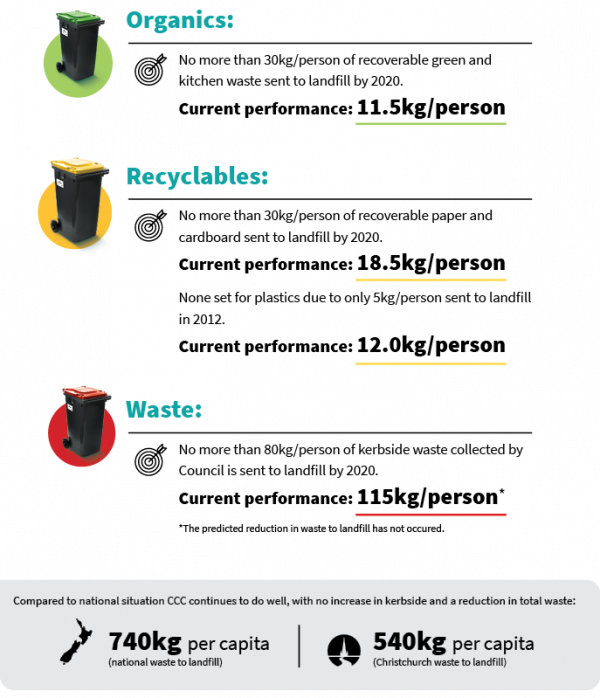
2013 Waste Targets
Key action areas since 2013
Here's a snapshot of some of the key action areas we’ve focused on to reduce waste to landfill, following the 2013 Waste Management and Minimisation Plan.
Education and raising awareness
Education and raising awareness are an important way to reduce the amount of waste that gets sent to landfill. Our programmes include:
Learning through Action
We offer a range of environmental programmes, including waste minimisation, free to schools. The programmes provide relevant and authentic learning experiences through hands-on activities, link to the school curriculum and focus on sustainability. Learning through Action is supported by the Ministry of Education as a Learning Experiences Outside The Classroom provider.
Four waste reduction Learning through Action programmes are delivered to all schools (200) in the Christchurch area:
- “Watch your Waste”
- “A Waste of Time”
- “Casting Magic with Worms”
- “Fertilising for the Future”
Throughout the last seven years (2013-2020) 18,698 students have been through these programmes. Education is provided to various additional groups, with the Learning through Action team able to cater to specific requests.
Contamination auditing
We have an education programme focused on reducing contamination in the kerbside bins. Our current programme focuses on ensuring that only the correct, clean items go in the yellow bin. By improving the quality of residential recycling, through direct kerbside education, more recycling is able to be processed and less material has to go to landfill.
Battery collection and recycling pilot
The components in batteries are harmful for the environment. They also pose a significant risk to kerbside bins and waste processing infrastructure, with Lithium-ion battery fires an emerging issue. We initiated a battery recycling scheme, enabling batteries to be disposed of safely. Batteries can be dropped off for free at seven locations across the city. As there are no viable recycling options in New Zealand, batteries are collected, sorted and prepared for shipping overseas.
Love Food Hate Waste
This is a nationwide campaign aimed at reducing household food waste(external link).[1] WasteMINZ has partnered with 60 councils, including Christchurch City Council, community groups and the Ministry for the Environment to deliver Love Food Hate Waste. Information provided includes recipes, practical tools, tips and techniques focused on reducing the amount of household food thrown out.
Waste minimisation for council’s operations
Our internal Resource Efficiency and Greenhouse Gas Emission programme focuses on being resource efficient and reducing greenhouse gas emissions from our activities.
Target Sustainability
Our Target Sustainability service assists Christchurch businesses to reduce solid waste and greenhouse gas emissions, and to be energy and water efficient.[1] We worked with Government agency Energy Efficiency and Conversation Authority, to deliver sustainable design advice on more than 500,000 square metres of commercial buildings.
Lancaster Park Stadium Deconstruction
A large amount of material was recycled and recovered during the deconstruction of Lancaster Park. As a result, less than 2 per cent of material went to landfill (1880 tonnes out of about 100,000 tonnes of overall waste).
Boilers were re-used to power the hot pools at Franz Josef.
Over 18,000 of the 30,808 seats were rehomed to community groups and individuals and the remainder recycled.
Concrete hard fill was used in the Lyttelton port reconstruction, a significant offset to mining these resources.
Our waste challenges are:
- Our recycling system relies on being able to sell most of our products overseas. We need to find local solutions to manage our waste and resources sustainably.
- Resource recovery services do not meet the growing expectations of residents for waste minimisation. We need to work with central government on waste minimisation initiatives and opportunities.
- Products that are no longer wanted frequently go to landfill, when they or their component materials still have value. We need solutions that allow us to recover or reuse products and materials.
Selling our products
Our recycling system relies on being able to sell most of our products into international markets. We need to identify local processes and opportunities to manage our own waste and resources sustainably.
What are the current on-shore barriers?
- A lack of processing infrastructure for certain types of waste material. For example, the current fibre processing plant is in the North Island and at capacity. The South Island does not have the scale to establish a new paper mill capable of processing New Zealand’s excess fibre and the costs of such a plant are significant.
- As on-shore recycling of fibre is unlikely to be viable, we need to consider alternative processes.
- Some recyclable commodities, for example plastic with recycling symbol 1, 2 and 5, and glass already have good local markets or robust export markets (metals). Other material still needs to be exported, including mixed plastics (3, 4, 6 and 7). A summary of the symbols is provided in Appendix C.
Key examples
- Currently the Materials Recovery Facility (MRF), where material from the kerbside yellow bins is sorted into commodity products, is not designed to meet increasingly tight contamination thresholds required internationally. Our current contamination rate of recycling received at the MRF is usually between five and eight per cent, typical of a mixed recycling service where all material is collected in one container. This level of contamination exceeds the prescribed quality standards established under the China National Sword policy – maximum acceptable contamination rate of just 0.5 per cent.
- New international legislation under the Norwegian Amendment to the Basel Convention, restricts mixed recycling. This means we’ll need to further sort (or restrict) plastic resins in order to export our recycling.
- New Zealand’s population means we have little influence on international markets and rely on favourable market conditions.
Discrepancy between public expectation and delivery
Resource recovery services do not meet the growing expectations of residents for waste minimisation. We need to work with central government on waste minimisation initiatives and opportunities.
Key examples
- From 1 July 2019, the Government banned retailers from supplying single-use plastic shopping bags under a certain thickness. This came from increased public awareness of the impact plastic has on our marine environment.
- The supermarket soft plastics recycling scheme was popular with consumers but failed when the international processor who recycled the materials stopped accepting them. The programme has been redeployed in the North Island at a relatively small scale, however is reliant on the demand for output products.
- Recycling costs are often not included directly in the purchase of goods. A shift towards producer responsibility, where a product manufacturer or retailer has greater responsibility for that product throughout its life cycle (including resource recovery/disposal) is needed. The Government has identified priority waste streams suitable for the development of mandatory product stewardship programmes.
- We’ve developed a successful collection pilot for handheld batteries, which we hope will lead to a product stewardship programme for this waste stream. The collection programme has been well received with high public demand for the service (collecting over 600kg of used batteries a month). We need businesses (manufacturers, retailers and importers) to take responsibility for these waste streams for such collections to be sustainable in the future.
- Resident surveys show good public support for the three-bin kerbside system. However, there is some confusion about which items can be recycled and inconsistent messages from different councils across the country.
Valuing our resources
Products that are no longer wanted frequently go to landfill, when they or their component materials still have value. We need solutions that allow us to recover or re-use products and materials. To get the best value from our resources we need to adopt circular approaches. Products and individual components need to be recovered and repurposed into other useful products that in turn can be reprocessed again.
Key examples
- While the cost of landfill remains (relatively) low, there is little incentive to invest in alternatives. The Government is addressing this with an increased and expanded waste levy announced in July 2020.
- New Zealand is heavily reliant on imported goods, making it hard to influence the design of products and difficult to adopt circular processes.
- Below outlines the average amount of recycling sent to landfill. This represents a direct loss of recyclable materials and a cost to send these valuable resources to landfill.
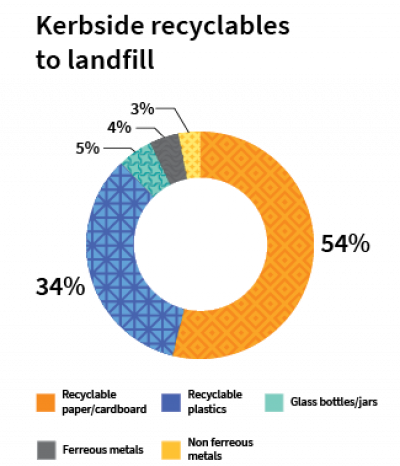
Kerbside recyclables sent to landfill
The life cycle of products, from extraction of the raw material through to the production process and distribution, varies hugely in terms of environmental impacts such as carbon emissions, energy and water use and bi-product waste. Plastics in particular have a significant emissions footprint, yet many are developed for single use packaging.
Transition challenges
Planning under uncertainty
This is a period of uncertainty for the resource recovery sector due to the ongoing changes in international recyclable product markets and the emerging national response programme. We need to develop flexible responses to the challenges we face across the solid waste and resource recovery services that we deliver. We need to maintain an awareness of the risks and opportunities of Government policy decisions regarding waste minimisation and climate change.
Climate change adaptation and ongoing management of closed landfills
We manage approximately 120 closed landfills within our district. This involves monitoring and mitigating potential environmental effects (such as capturing landfill gas at the closed Burwood Landfill) and the risks posed by natural hazards and climate change. Fifteen closed landfills are in potentially vulnerable locations (e.g. in low-lying and coastal areas or near rivers). These are unlined, unsealed and contain unknown materials. They are vulnerable to coastal flooding, erosion, storm surge, rising ground water and increased river flows.
Operational challenges
Glass
The low price of glass and the transport costs of sending it to the North Island is a barrier to recycling. Christchurch’s glass is used locally by the construction industry.
Providing a mixed recycling bin service that includes glass, plastic and paper can contaminate the individual product types, e.g. broken glass in the mixed paper stream. This challenge is addressed in the feasibility study developed by EcoCentral and we will continue to explore the options.
Contamination
Our ability to divert waste from landfill relies on the correct use of our three-bin system. The quality of recycling determines whether the product can be on-sold. To combat contamination of our kerbside bins, we’ve started a “gold star” recycling campaign, where people recycling correctly are recognised with a gold star on their bins. This has been well received publicly and identifies everyone’s contribution to effective resource recovery. Problematic items that end up in the recycling bin include soft plastics, lids, steel items, nappies, organic waste and general household goods.
We operate a three-strike system for repeated contamination of recycling or organics bins. This provides us with the opportunity to educate residents who may be unaware of which items can go in each bin, prior to removing the service.
Bromley Odour
In June 2020, Environment Canterbury released findings of a pilot study focused on identifying sources of odour in Bromley. The pilot study findings identified two facilities – Living Earth Organics Processing Plant and the EcoCentral EcoDrop – as significant odour emitters.
In response to the findings, we’ve worked with EcoCentral and Living Earth to develop an action plan outlining the short, medium and long-term options to mitigate odour at these facilities.
Impacts of Covid-19
The COVID-19 pandemic has caused economic upheaval globally and nationally. The response has had a direct impact on resource recovery, including the temporary closure of facilities during the lockdown, lack of access to and uncertainty regarding overseas markets, and increased contamination challenges post-lockdown.
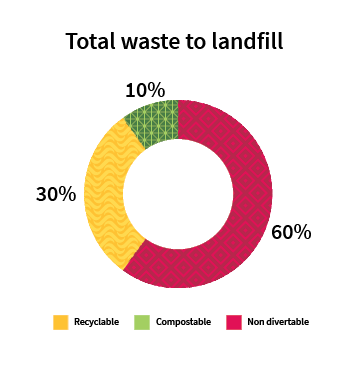
The following assessments and reports provide the foundations for our plan.
Waste Assessment 2019
The 2019 Waste Assessment provides the evidence base for this plan. It describes our waste generation and outlines options for meeting future demand.
To understand the potential for waste diversion from landfill, we commissioned EcoCentral to complete two audits on our current waste collections. These audits looked at what was going into kerbside red bins and what waste was taken to transfer stations. The audit results describe the types and quantities of materials discarded via our collection system.
https://www.mfe.govt.nz/sites/default/files/media/Waste/wmmp-guide.pdf (external link)
The above 2018 Waste Audit shows that:
- 39.6 per cent of total material going to landfill from our facilities could be diverted as recycling (29.9 per cent) and organics collections (9.7 per cent), as shown in Figure 10. This is the equivalent of 46,000 tonnes that could have been diverted from landfill.
- From our kerbside collection, the landfill diversion potential was 31 per cent recyclable, 11 per cent organics.
- From the transfer station, the landfill diversion potential was 28 per cent recyclable, six per cent organics.
Further waste reduction could be achieved through a targeted programme. We’ve developed a collection network for batteries and provide household hazardous waste and electronic waste disposal facilities at our EcoDrop Recycling Centres. Other waste reduction opportunities to explore include:
- Timber recovery (including treated timber) - 8 per cent
- Textile recovery/recycling - 5.5 per cent
- Electronic waste – 2.25 per cent
Waste management and minimisation Blue Sky Scan 
in 2019, we commissioned Arup to undertake a scenario planning exercise to inform and future-proof this plan. Local and global trends were identified to develop a set of conceptual future scenarios. This led to four possible scenarios, as well as 11 recommendations for us to consider when preparing this plan.
Two key variables were identified:
- Christchurch being integral in driving future change for the region and how collaboratively we work with surrounding councils to allow scalable solutions
- whether business models change to be more circular or not.
This enabled four possible scenarios to be developed to stimulate thinking on where we are potentially heading (see below), as well as eleven high-level recommendations that have been considered as part of the action plan.
High-level recommendations.
1. Create a common language to replace traditional discussions about waste
2. Act as a matchmaker to create a community to share industrial products
3. Continue the education programme but increase the reach
4. As a council, lead by example by going zero waste
5. Review recyclable quantities and evaluate which products should be locally processed
6. Explore synergies between multiple essential services such as wastewater and waste
7. Review opportunities for energy from waste as part of a long-term overall solution
8. Promote and embrace product stewardship schemes
9. Implement procurement policies for single-use plastics and limit imports for problem waste
10. Reduced planned obsolesce and create repair shops and tool libraries
11. Develop data solutions for customer profiling and waste collection analytics
Waste to energy study
In 2017, we commissioned Just Add Lime to undertake a programme business case. This was aimed at better understanding the disruption and the potential impact on waste and recycling operations, and to explore opportunities that best manage Christchurch’s waste and recycling in the future.
Two problems were identified, which have been recognised and are addressed within this plan:
- Council’s waste and recycling system is fragmented and involves a number of suppliers delivering discrete services, often resulting in duplication, and competing objectives and drivers.
- The fundamental shift occurring in the global waste and recyclable markets, including countries no longer processing global waste and recyclables, increasing market volatility, and increasing customer awareness of waste and recycling practices.
Options were developed to address these problems. The recommended programme utilises waste to energy processes to manage waste and recycling. This is based on three components:
- Recovering energy from the city’s waste and recycling
- Improving operational efficiency and effectiveness
- Developing incentives to encourage waste minimisation
The expected outcomes include reducing the volume of waste and recyclables going to landfill by 70 per cent and applying principles of kaitiakitanga and best practice to sustainably managing the city’s waste and recycling.
Our next steps include deciding whether to proceed with a detailed business case, exploring the financial costs in greater detail as each waste to energy option is considered.
The estimated investment required for the recommended programme is dependent on the type of waste-to-energy process selected for Christchurch. Further, the detailed business case will identify different delivery options; including partnerships with industry, which could be used to manage our financial and risk exposure.
EcoCentral feasibility study
EcoCentral has developed a feasibility study looking into the future of recycling within Christchurch and parts of Canterbury. It includes the following options for consideration:
- Exclusion of glass from kerbside recycling collection to increase paper quality
- Exclusion of certain plastics from kerbside recycling collection (resin codes 3,4,6,7 – See Appendix C for summary of plastic recycling codes) to increase the commodity value of mixed plastic
- Investing in additional sorting technology at the Materials Recovery Facility for mixed plastics and fibre (paper and cardboard) to minimise contamination
- Waste to energy opportunities for residual processing waste
We’re working with EcoCentral on these options and opportunities for Christchurch. In the short-term we are focussing on maintaining our current markets while looking at local and national alternatives.
Living Earth case study
We’re developing a case study to look at alternative disposal options for paper and cardboard. This could involve composting paper through the Living Earth facility should markets for recycling fail. If possible, this could lead to the potential inclusion of paper and cardboard in the kerbside collection system.
Achieving our vision involves short-term actions, a review of our current service and maintaining our focus on the vision and long-term goals. Each of these is outlined in more detail below.
Action plan
An action plan has been developed and is included as Appendix B. It’s a living document that supports this plan, providing both immediate short-term actions and a responsive approach to waste sector challenges. The action plan will be reviewed and updated annually to ensure we’re able to adapt and respond to the changes in resource recovery nationally and internationally. Progress against these actions will be reported to the Three Waters, Infrastructure and Environment Committee.
We’ve used the evaluation framework and actions from the blue sky scan to help develop the action plan. The actions address five key themes:

Service delivery review
In June 2020, the Council decided to carry out a service delivery review of resource recovery services. The expectations of the review are outlined in section 17A of the Local Government Act. The review will consider options focused on governance, funding and delivery that can improve cost effectiveness.
The review is expected to start in August 2020 with recommendations going to the Finance and Performance Committee in June 2021.
Working towards the long-term vision
Our long-term vision is for a sustainable Ōtautahi Christchurch, working towards zero waste and a circular economy. This will maximise the sustainable use of resources and support a strong response to climate change. We need to work with our treaty partners, industry, central Government and other councils to achieve the necessary changes to reduce our dependence on international markets for recyclable materials and invest in infrastructure for local solutions. Regional and national collaboration will be essential to minimise waste and achieve our transition to a low carbon, circular economy.
Our resource recovery services are funded through rates (providing flexibility for different service levels), fees and charges, and levy revenue.
Rates
Rate charges that pay for our transfer stations, kerbside collection, processing and disposal costs, waste minimisation and education activities and landfill aftercare are:
- Uniform Annual General Rate Charge - $132 per year
- Waste Minimisation Targeted Rate - $181.11 (part charge $135.83)
In respect of the rates revenue, residual waste is funded by the uniform charge, while recycling and organics are funded by the targeted rate.
Currently there are approximately 165,000 rating units charged the uniform charge and approximately 153,000 paying the targeted rate. As part of a service delivery review of resource recovery services, differential charging, including the ability to motivate waste reduction through user pays, will be considered.
Inner-city kerbside collection
The price of the inner city recycling and rubbish bags covers the cost of providing this service. Charges are reviewed annually with current 2020 charges as follows:
- Rubbish (red) bags are 50 litres and cost $13.40 for a pack of five.
- Recycling (yellow) bags are 50 litres and cost $5.43 for a pack of five.
Waste levy
For every tonne of waste sent to landfill, central Government applies a $10 levy under the Waste Minimisation Act 2008. In 2019, Government signalled that they were looking to expand this levy to all sites and implement a staged increase in the rates charged.
Based on the current tonnages sent to landfill, we contribute approximately $1.14 million in levy payments. Half the total levy collected is made available in an annual contestable fund (Waste Minimisation Fund) with the remainder distributed to councils on a per- capita basis.
Through the levy, we currently receive approximately $1.4 million each year to promote waste minimisation in accordance with this plan.
Table 2 below shows the impact of the levy. This does not take into account the reduced tonnage that the levy is expected to achieve. However, even with reduced volumes to landfill, it is expected that this mechanism will provide increased funds to support waste minimisation and the delivery of our action plan.

Impact of change to levy rates and revenue
Canterbury Waste Joint Committee grants funding
The Canterbury councils have formed the Canterbury Waste Joint Committee to coordinate regional collaboration across the resource recovery sector. A major role of the committee is the contribution to, and administration of, an annual contestable fund. Established under section 47 of the Waste Minimisation Act 2008, the fund provides grants to innovative projects that deliver waste minimisation objectives.
Approximately $112,000 annually is allocated by the Canterbury Waste Joint Committee to support innovation and regionally applicable waste minimisation projects.
Revenue from divertible materials and recovery facilities
Revenue generated across our resource recovery facilities offsets operational costs. This includes a rebate paid on incoming commercial tonnages at the Organics Processing Plant and a gate fee at the Burwood Resource Recovery Park. While contributions from each facility vary, they do help offset the cost of our services.
For example, revenue generated by the Burwood Resource Recovery Park (approximately $3 million per annum) contributes to the cost of both operating the facility, and rehabilitating the site after it closes at the end of 2020. The provision of a disposal facility for waste generated from the Canterbury earthquakes has directly supported the recovery process. It’s also significantly reduced transportation of soil, construction and demolition materials that would otherwise be sent to the Kate Valley Landfill.
In 2018, a taskforce was established in response to the Chinese government's effective ban on the import of many recycling materials.
The taskforce’s report recommendations [1] are now part of the Ministry for the Environment’s work programme[2]:
- Forming a plan to phase out low-value and hard-to-recycle plastic packaging
- Design of a New Zealand beverage container return scheme[3]
- Expanding and improving the waste disposal levy (landfill levy) to more of New Zealand’s landfills and improving our data on waste[4] [5]
- Improve kerbside and commercial recycling, reduce contamination of recyclables so more materials can be recovered, and increase onshore processing of plastics and other materials[6]
- Analysing where investment in innovation and resource recovery infrastructure is most needed to support New Zealand’s transition to a circular economy approach.
- Developing a national circular economy strategy, starting with priority sectors where the greatest benefits can be gained from transitioning to a circular economy approach.
- Implementing product stewardship schemes for problematic waste streams including vehicle tyres, e-waste (starting with lithium-ion batteries), agrichemicals and synthetic greenhouse gases[7]
Proposals for short to medium-term responses to China's National Sword Policy[8] have been developed. The proposals consider national options to manage the effects of fluctuations in recycling material commodity prices on our resource recovery sector. The impacts of price changes are felt internationally, with Australia’s experiences and responses reflected in the report. Possible identified responses include:
- Education to reduce contamination
- Review domestic kerbside collection systems and stop collecting plastic grades 3-7 (limited viable markets)
- National facility licence limits (improves data capture and Material Recovery Facilities coordination)
- Regulate recyclability of packaging
- Regulate recycled content of packaging
In response to these challenges, there is a greater focus on working towards a circular economy approach.[9] This is the idea that all products can be made so that at the end of their initial use they have a value (e.g. can be re-used, recycled or repurposed). This reduces waste, pollution and greenhouse gases.
[1] https://www.mfe.govt.nz/publications/waste/national-resource-recovery-project-situational-analysis-report(external link)
[2] https://www.mfe.govt.nz/waste/waste-and-government(external link)
[3] https://www.mfe.govt.nz/waste/new-zealand-container-return-scheme(external link)
[4] https://www.mfe.govt.nz/waste/waste-disposal-levy(external link)
[5] https://www.mfe.govt.nz/consultations/landfill-levy(external link)
[6] https://www.beehive.govt.nz/release/plan-recharge-recycling(external link)
[7] https://www.mfe.govt.nz/consultations/priorityproducts(external link)
[8] https://www.mfe.govt.nz/publications/waste/proposals-short-medium-term-responses-national-sword(external link)
[9] http://web.archive.org/web/20200114132214/https://www.mfe.govt.nz/waste/circular-economy(external link)
The 2020/21 Draft Action Plan, sets out the key activities towards achieving the objectives of Te mahere whakahaerenga para, Waste Management and Minimisation Plan 2020.
Activities are split into existing commitments and future actions for us, the community and central Government, recognising the necessary inclusion of those outside of Council, also responsible for waste produced. The success of long- term elements of this plan will rely on the adoption of new approaches to managing our resources, and the shift towards a circular economy and zero waste.
The following objectives have been developed to measure the effectiveness of this plan (See Section 7: A vision for the future):
1. Shared use of the Organics Processing Plant and Materials Recovery Facility
2. Joint communications and public information
3. Working together to deliver innovation in the waste sector
4. Working towards establishing a regional infrastructure strategy for waste, recycling and organics
5. Potentially developing regional waste management and minimisation plans in the future.
Our action plan addresses five key themes: Diversion of organics from landfill, Diversion of recyclable materials from landfill, Diversion of hazardous substances from the environment, Provision of leadership and innovation in the Christchurch waste sector, and education and communications.
Within the five themes are 12 focus areas. Each focus area shows the objective(s) aligned to support measuring its success.
We can deliver many actions, but some require support or leadership from either the commercial sector or central Government. The following colours are used to outline who is responsible for each action.

